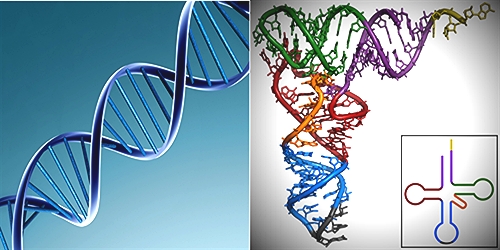Difference between DNA and RNA

Medical science is so advanced that we can properly talk about blood circulation, and any issue related to blood. The terms used in medical science for two different kinds of molecules present in the body are DNA and RNA. We often listen to these terms in our daily lives but hardly anyone of us knows the difference and the purpose underlying behind these two molecules. What are they and what’s the difference between DNA and RNA, we’ll further know all about it.
What is DNA?
DNA stands for Deoxyribo Nuclei Acid. It is a molecule in which sugar is present and in medical terms it is known as deoxyribose. As far as its definition is concerned, it is a nuclei acid that contains genetic instructions which are used in the functioning of all living organisms.
What is RNA?
RNA stands for Ribo Nuclei Acid. This molecule is called ribose which is mainly known for the molecule present in it. More scientifically, it is believed that RNA is the main genetic material in original life forms. It is a chain of alternating phosphate along with the bases of adenine, cytosine and uracil. They are involved in the transmission of the genetic information.
DNA vs RNA
How the molecules function in body and unique features they possess?When it comes to DNA, it is known as the medium of the long term storage and the transmission of the genetic information in body. On the other hand, RNA transfers the genetic codes that are basically needed for the creation of the proteins from the nucleus to the ribosome.
When we look thoroughly into the features of DNA, the helix geometry is b-form and also DNA is tightly packed and it is protected in the nucleus. It can be damaged by the exposure of the ultra-violet rays.
On the other hand, RNA belongs to the geometry of A-form. They are sensitive and get more damage when are attacked by ultra violet rays. Their strand gets broken down and reused again and again.
How it looks like? Apparently, DNA is the double stranded molecule along with a long chain of nucleotides. It consists of a long chain. On the other hand, RNA is the single stranded molecule. It consists of a shorter chain of nucleotides.
What are the bases and sugars associated with these two? And how Pairing can be done?
DNA consists of two sugars named, Deoxyribose sugar and phosphate backbone. As far as the bases are concerned, it has four bases which are as follows:
- Adenine
- Guanine
- Cytosine
- Thymine
It’s pairing can be done as A-T (Adenine-Thymine), G-C (Guanine-Cytosine).
On the other hand, RNA has two sugars as well which are named as Ribose Sugar and Phosphate Backbone. It has also four bases on which the whole functioning depends, the bases area as follows:
- Adenine
- Guanine
- Cytosine
- Uracil
RNA pairing can be seen as A-U (Adenine-Uracil), G-C (Guanine-Cytosine)
How much Stability they both retains? The sugar in DNA is less reactive because the bonds of c-h is involved in it. The bonds are much stable in alkaline conditions. They have smaller channels which prevents it from attack from enzymes.
On the other hand, RNA’s molecule Ribose is much more reactive because of hydroxyl bonds are involved in it. They are not stable in alkaline conditions. They have larger channels which makes it easier to be attacked by enzymes.
Which evolved first?
Evidences suggest that DNA may have transpired first, but most of the scientist are convinced that RNA metamorphosed before DNA. RNA has a simple structure and is required so that DNA may function. RNA lays hold of prokaryotes.
The important question that arises is that why DNA evolved if DNA exist. The accurate answer for this is that having the double-standard molecule aids in protecting the genetic code from damage. In case, anyone strand is broken, the other strand serves a platform for repair. Proteins that surround the DNA grant extra protection to DNA from enzyme attack.
Location
- DNA: It is mostly found in the nucleus and nucleoid.
- RNA: It is mostly found in the cytoplasm
Stability:
In alkaline conditions DNA is stable, because of the small size of the grooves, the action of DNase enzymes is minimized. In if we take a look at the stability of RNA, it is not as stable in alkaline conditions as DNA is. RNA possesses a lot larger grooves as compared to DNA and it is liable to degrade with RNAs.
Damage caused due to UV:
DNA is more likely to be damaged by UV, while RNA has less chances of the damage due to UV.
Conclusion:
RNA and DNA are very alike in structure as DNA is the double stranded molecule along with a long chain of nucleotides while RNA is the single stranded molecule. It consists of a shorter chain of nucleotides. Let’s look at this example i.e both of these has phosphate groups and nitrogenous bases. The main differences between these both is that DNA utilizes the sugar deoxyribose while RNA utilizes the sugar ribose. DNA also has the bases A, G, C, and T while RNA has A, G, and C but uses U as a replacement of T. The similar difference between DNA-DNA and DNA-RNA base pairing is that in order to pair DNA-RNA each A on the DNA strand is in association with a U that is on the RNA strand.


Leave a Reply